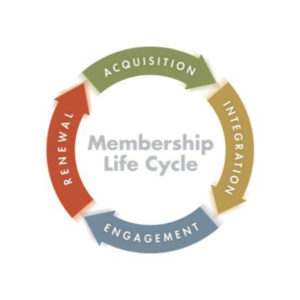 We have explored the challenges and best practices of the Acquisition and Integration stages of the Membership Life Cycle. In this month’s issue, we explore the best practices to implement for Stage 3: Engagement. Don’t miss the December issue where we will explore best practices for the Renewal stage.
We have explored the challenges and best practices of the Acquisition and Integration stages of the Membership Life Cycle. In this month’s issue, we explore the best practices to implement for Stage 3: Engagement. Don’t miss the December issue where we will explore best practices for the Renewal stage.
Stage 3: Engagement Levels of Members
Most organizations have found a strong correlation between engagement and retention of members. Engagement is more broadly defined than “participation of events” and includes open rates of e-mails and e-newsletters, web site visits, clicking on links, responding to surveys and polls, participating in committees, councils and task forces, volunteering and connecting through social media platforms. Although tracking engagement levels of members can be difficult depending on organizational resources (e.g., time, staff, technology), the more that can be monitored and influenced, the higher likelihood of higher retention rates and member loyalty.
The most common challenges organizations face in this stage include:
- Lack of technology or resources to document, track and monitor engagement levels
- Lack of time for members to engage more due to their own resource constraints
- Member apathy or indifference to engage on a consistent basis
- Identifying and agreeing on the definition of engagement
- Quantifying and tracking engagement through non-registered activities or social media interactions
Best Practices for the Engagement Stage:
- Create Circles of Engagement that Influence Member Involvement
- Birds of a Feather Flock Together — provide opportunities for members with similar needs and/or interests to interact, work on shared goals, and share best practices. These opportunities include SIGS (Special Interest Groups such as a Women’s Council, Young Professionals Group, Solo-Entrepreneurs or Industry Roundtables) who interact face-to-face or virtually through social media group), task forces, and committees or councils.
- Networking or Business Exchange Opportunities — many members enjoy meeting with other members to promote their businesses or to build stronger connections. Provide face-to-face, virtual (through social media), list serve opportunities to meet members needs on a 24/7 basis. Recognize that all members can attend face-to-face opportunities due to resource constraints yet still have a need to connect with other members.
- Leverage Social Media Platforms to Engage, Educate, and Promote Members—social media platforms such as Facebook and WordPress allow organizations and their members to share information, connect with others, and promote one another. Volunteers, leaders and staff can facilitate the process proactively to ensure that activity is consistent and that inquiries and concerns are addressed. (We offer additional engagement strategies as an important component of a retention plan in our Member Retention Kit, Section IV, Strategic Direction: Where Do We Go from Here?)
- Collect feedback from members on a regular basis
- Conduct an Annual Membership Survey — collect feedback on the organization’s strategic direction, benefits and services, current and emerging needs, and loyalty levels. Using an online survey tool allows for reminders to be sent electronically, results to be compiled and analyzed, and visual charts to be displayed. If response rates are not high, consider collecting feedback through interviews and focus groups as well. (We offer tips for testing for loyalty as an engagement strategy in our Member Retention Kit.)
- Conduct Periodic Polls on Specific Topics — offer short polls on the web site that get a pulse from members on specific topics like web site features, current advocacy initiatives or industry/community concerns. Share the results with members so they can compare their perspectives to others.
- Monitor member engagement levels
- Run Engagement Reports Periodically — leverage the power of the membership management database by entering engagement data and running reports to identify high, medium and low engagers. Thank highly-engaged members and recognize their loyalty, and target lower-engaged members monthly who may be at risk of attrition.
